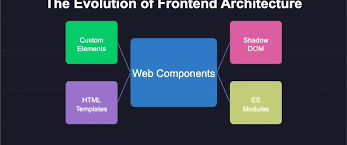The landscape of frontend development continues to evolve at a dizzying pace. As we navigate through 2025, developers have an ever-expanding ecosystem of frameworks and libraries to choose from, each with its own philosophy, strengths, and ideal use cases. This comparative analysis explores the current state of the most popular JavaScript frameworks and helps developers make informed decisions for their projects.
The Current Frontend Ecosystem
The front-end ecosystem has consolidated somewhat since the framework explosion of the previous decade, but we still maintain a healthy diversity of approaches. While some frameworks have faded, the major players have evolved significantly, with a general trend toward better performance, improved developer experience, and more flexible architecture.
Interestingly, we've seen convergence in certain areas—almost all frameworks now offer some form of component-based architecture, reactive state management, and improved rendering patterns. Yet they continue to differ in their core philosophies and implementation details.
React: The Flexible Ecosystem
React, now in version 20, remains the most widely used frontend library, with an estimated 45% market share among professional developers. Its primary strengths continue to be its flexibility and the vast ecosystem that has developed around it.
The introduction of React Server Components has matured considerably, fundamentally changing how many React applications are built by blurring the traditional boundaries between server and client rendering. The latest Suspense features provide elegant handling of loading states and asynchronous operations.
React's ecosystem continues to be its greatest asset, with frameworks like Next.js (now version 15) providing robust full-stack solutions that handle routing, data fetching, and server-side concerns. Meanwhile, Remix has gained significant adoption for its focus on web fundamentals and progressive enhancement.
React's "learn once, write anywhere" philosophy continues to pay dividends with React Native's strong position in the cross-platform mobile development space.
Best for: Large applications with complex requirements, teams that value ecosystem flexibility, projects that might need native mobile versions.
Vue: The Progressive Framework
Vue.js, now in version 4, has maintained its position as the second most popular framework, with approximately 25% market share. Its reputation for being approachable and progressively adoptable remains strong.
Vue 4 built upon the Composition API introduced in Vue 3, further refining the reactivity system and providing even more powerful composable utilities. The latest version has also significantly improved performance, particularly in large applications where fine-grained reactivity really shines.
The Vue ecosystem has continued to mature with Nuxt (now version 5) offering a comprehensive framework experience similar to Next.js, but with Vue's design philosophy. Pinia has become the de facto state management solution, offering a simpler yet powerful alternative to the original Vuex.
Vue's single-file component format remains a distinctive and beloved feature, providing clear separation of concerns while keeping related code together.
Best for: Teams transitioning from traditional web development, projects that require progressive adoption, applications that benefit from clear architecture conventions.
Angular: The Enterprise Solution
Angular (version 18) has continued its evolution as a comprehensive platform rather than just a framework. With approximately 20% market share, it remains particularly strong in enterprise environments.
The introduction of Angular Signals has revolutionized how Angular handles reactivity, moving away from its traditional change detection system to a more fine-grained reactive approach. This has dramatically improved performance in complex applications.
Angular continues to offer the most comprehensive "batteries-included" solution, with built-in tools for routing, forms, HTTP communication, and testing. The Angular CLI has further improved developer experience with intelligent code generation and automated optimizations.
TypeScript integration remains seamless, with Angular leveraging the latest TypeScript features to provide robust type checking and excellent tooling support.
Best for: Enterprise applications, large teams with defined processes, projects requiring strong architectural guidance and long-term maintenance.
Svelte: The Compiler Approach
Svelte (version 5) has continued to gain market share, now used by approximately 12% of developers. Its compiler-centered approach, which shifts work from runtime to build time, continues to yield performance benefits.
Svelte's latest major release has expanded its "rethinking reactivity" approach with even more elegant syntax for common UI patterns. The framework's signature feature remains writing components that feel like enhanced HTML, CSS, and JavaScript without requiring developers to learn extensive framework-specific abstractions.
SvelteKit has matured into a full-featured application framework comparable to Next.js or Nuxt, handling routing, server-side rendering, and API endpoints with minimal configuration.
The relatively smaller ecosystem compared to React or Vue has expanded considerably, though it still lags behind the major players in terms of third-party component libraries and specialized tools.
Best for: Performance-critical applications, smaller teams that value simplicity, projects where bundle size is a primary concern.
Solid: The Reactive Optimization Leader
Solid has continued its remarkable growth, now capturing about 8% of market share. Building on reactive principles similar to signals in Angular and the Composition API in Vue, Solid takes fine-grained reactivity to its logical conclusion.
The framework maintains its React-like JSX syntax but with a fundamentally different rendering model—components render only once, with only the precise parts of the DOM that need to change updating when state changes.
SolidStart has emerged as a strong meta-framework, providing server-side rendering, file-based routing, and deployment integrations with minimal configuration.
Solid's ecosystem, once its primary weakness, has grown significantly, though it still can't match the breadth of options available to React or Vue developers.
Best for: Applications where performance is critical, developers familiar with React who want better performance, projects starting from scratch that don't need extensive third-party libraries.
Emerging Trends
Several key trends have emerged across the frontend ecosystem:
Islands Architecture: The concept of hydrating only interactive parts of the page has gained traction, with all major frameworks now offering some variant of partial hydration.
Edge Rendering: Server components and server-side rendering are increasingly deployed at the edge, reducing latency and improving user experience globally.
Streaming Rendering: Progressive rendering techniques that allow for faster initial page loads have become standard across frameworks.
Zero-Bundle JavaScript: There's growing interest in reducing or eliminating client-side JavaScript where possible, with frameworks now supporting "progressive enhancement" approaches that deliver HTML first with optional JS enhancement.
Making the Choice
When choosing a framework in 2025, consider the following factors:
Team Experience: Leveraging existing knowledge can significantly impact productivity.
Project Requirements: Match the framework's strengths to your specific needs.
Ecosystem Requirements: Consider whether you need specific libraries or integrations.
Performance Needs: If absolute performance is critical, frameworks like Svelte and Solid have an edge.
Long-term Maintenance: Consider the framework's stability and community support.
In conclusion, there's never been a better time to be a frontend developer. The tools at our disposal continue to improve in power, performance, and developer experience. While the choices can seem overwhelming, each major framework represents a thoughtful approach to solving the fundamental challenges of building for the web, and all are capable of producing excellent user experiences in the right hands.



